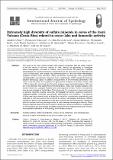| dc.description.abstract | The caves of the Irazú volcano (Costa Rica), became accessible after the partial collapse of the NW sector of the Irazú volcano in 1994, offering the opportunity to investigate active minerogenetic processes in volcanic cave environments. We performed a detailed mineralogical and geochemical study of speleothems in the caves Cueva los Minerales and Cueva Los Mucolitos, both located in the northwest foothills of the main crater. Mineralogical analyses included X-ray diffraction (XRD) and Raman spectroscopy, while geochemical characterization used Energy Dispersive X-ray spectroscopy (EDX) coupled to Scanning Electron Microscopy (SEM). In addition, measurements of environmental parameters in the caves, cave drip water and compilation of geochemical analyses of the Irazú volcanic lake (~150 m above the cave level) and fumarole analyses were conducted between 1991 and 2014. We identified forty-eight different mineral phases, mostly rare hydrated sulfates of the alunite, halotrichite, copiapite, kieserite and rozenite groups, thirteen of which are described here as cave minerals for the first time. This includes the first occurrence in cave environments of aplowite, bieberite, boyleite, dietrichite, ferricopiapite, ferrinatrite, lausenite, lishizhenite, magnesiocopiapite, marinellite, pentahydrite, szomolnokite, and wupatkiite. The presence of other new cave minerals such as tolbachite, mercallite, rhomboclase, cyanochroite, and retgersite, is likely but could not be confirmed by various mineralogical techniques. Uplifting of sulfurous gases, water seepage from the Irazú volcanic lake and hydrothermal interactions with the volcanic host rock are responsible for such extreme mineralogical diversity. These findings make the caves of the Irazú volcano a world-type- reference locality for investigations on the formation and assemblage of sulfate minerals and the biogeochemical cycle of sulfur, with potential implications for Astrobiology and Planetary science. | es_ES |


